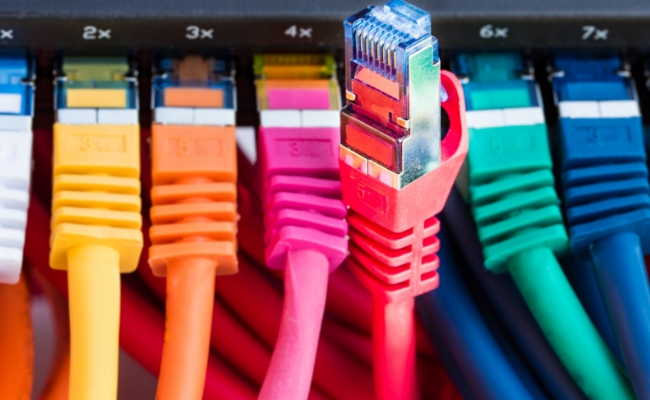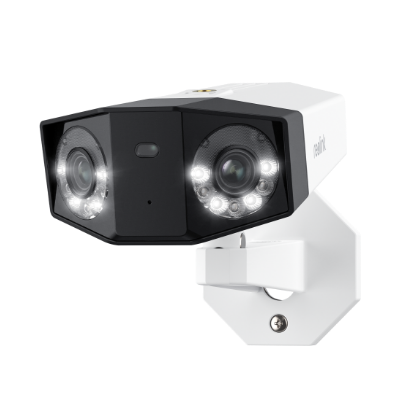What is an Ethernet Cable? Everything You Need To Know

Ethernet cables are commonly used to connect devices like computers, routers, and NVRs. But only some people are familiar with the science behind it. That’s why people struggle to choose the right Ethernet category and type.
In this article, we’ll take a deeper look at what an Ethernet cable is and how it is classified. We’ll also discuss the factors you need to consider while buying Ethernet cables.
Basics of Ethernet
We can divide the basics of the internet into two parts: definition and working.
What is ethernet?
An Ethernet cable is a medium for transmitting data from one point to another in a network. It is just like a multi-core wire that physically connects devices and gives them access to a network, such as a Local Area Network (LAN) or Wide Area Network (WAN).
Ethernet was commercially introduced in 1980 but is still preferred due to its speed and reliability. We use it to connect our devices, such as laptops, IP cameras, routers, NVRs, etc. However, it has evolved over the years; that is how we have multiple categories and types.
How does an ethernet cable work?
An Ethernet cable has multiple insulated copper strands that carry electrical signals.
Connecting the cable from one device to another creates a physical wire connection between them.
The packets transfer on these wires in the form of 1s and 0s and reach the other end. That’s how the cable facilitates the transfer of data.
What Does an Ethernet Cable Look like?
An Ethernet cable looks like a phone cable from the outside. When you remove the outer covering, you see multiple wires, each of one copper strand.
There are eight wires, and all of them are color-coded with different colors and combinations. They are twisted into four pairs and must be connected in a specific fashion.
A special connector, RJ45, is used to terminate the cable. It is inserted into the female port of the device.
Types and Categories of Ethernet Cable
Ethernet cables are available in different types and categories. Before choosing an Ethernet cable, you need to better understand these.
Types of ethernet cables
Ethernet cables are prone to noise interference and crosstalk. Therefore, shielding is used to solve these. The presence and different arrangement of shielding create different types of Ethernet cables.
-
UTP: Unshielded Twisted Pair (UTP) is the most basic Ethernet cable. It does not have any shielding; however, the pairs are twisted. It is also known as U/UTP.
-
STP: Shielded Twisted Pair (STP) has braided shielding around each twisted pair.
-
FTP: Foil Twisted Pair (FTP) has foil shielding around each twisted pair. It is also known as U/FTP.
-
F/UTP: Foil/Unshielded Twisted Pair (F/UTP) has a foil shield under the sheath. This shield is wrapped around the pairs collectively.
-
S/UTP: Braided/Unshielded Twisted Pair (S/UTP) has braided shielding under the sheath. It wraps around all pairs collectively.
-
S/FTP: The braided/foil-twisted pair (S/FTP) has braided shielding under the sheath. Each pair is also shielded with foil.
-
S/STP: Braided/Braided Twisted Pair (S/STP) has braided shielding under the sheath. Plus, there is braided shielding on individual pairs.
Categories of ethernet cable
In Ethernet cables, you’ll notice “CAT,” which means category. Along with it, there is a number that indicates that version.
You’ll commonly see the following categories of Ethernet cable.
-
CAT5: It is used for 100BaseT networks and offers a data rate of up to 100Mbps and a maximum frequency of 100MHz. It is not recognized by TIA/EIA and is obsolete now.
-
CAT5e: The “e” stands for “enhanced,” which means it is the enhanced version of CAT5. It offers a better speed of up to 1Gbps and reduces the chances of interference. It is the most affordable Ethernet cable, commonly used for household internet.
-
CAT6: This Ethernet cable offers data rates up to 10Gbps for short distances and 1Gbps for longer distances. It also has shielding, which makes it better at preventing noise interference. Plus, there is a nylon separator inside the cable that keeps the four pairs away to reduce crosstalk. It offers a maximum frequency of 250MHz.
-
CAT6a: The “a” stands for “augmented.” It is much better than CAT6 in terms of bandwidth and speed. The maximum frequency is up to 500MHz. It maintains the data rate of 10Gbps for longer distances. Another salient feature of CAT6a is the shielding to stop crosstalk.
-
CAT7: This is a shielded cable with individual shielding for all four pairs. It offers data rates up to 10Gbps, which can exceed 100Gbps for shorter distances. The maximum bandwidth is over 600MHz. It is specifically built for high performance.
-
CAT8: It is the latest category of Ethernet cables with a data rate of up to 40Gbps and bandwidth of up to 2,000MHz. It is just the extreme level that ensures incredible speed, no interference/crosstalk, and long-distance performance.
What is an Ethernet Cable Used For?
An Ethernet cable is used for data transfer. In simple words, it provides an internet connection to devices and connects them to the network.
Here are some common devices that use Ethernet cables.
-
Laptop: A laptop requires an Ethernet cable to get access to stable and fast internet. However, most people prefer to connect laptops through Wi-Fi.
-
TV: Smart TVs allow you to see content using the internet, and that’s why they need an Ethernet cable.
-
Security Camera: These cameras process recordings and then transmit them to NVRs for storage. They use an Ethernet cable for the transfer of data. The PoE cameras also use Ethernet cables to power themselves.
-
Game Consoles: These require high-speed and stable internet connections for a smooth gaming experience. Users prefer to use an Ethernet cable to connect their gaming consoles.
-
Smart Assistants: These require internet access to work, so they can be connected to the internet through an Ethernet cable.
-
Router: A router requires a wired internet connection through an Ethernet cable. That’s how it gets access to the internet.
How to Choose an Ethernet Cable?
These are a few important factors you need to consider while buying an Ethernet cable.
Devices connected via ethernet cable
Consider the devices you need to connect via the Ethernet cable. If they are simple routers and NVRs, CAT5e could work, and if you want better performance, you can go with CAT6.
But for high bandwidth and special needs, you need to go with better Ethernet cables. For core infrastructure, you can go with CAT7 or higher.
Transfer speed requirements
Each category of Ethernet cable has a maximum speed limit, which we have discussed in this article. According to your speed requirements, you can choose a suitable Ethernet cable.
For instance, if your speed requirement is under 1Gbps, CAT5e or CAT6 would be suitable. You don’t need to buy CAT6a, CAT7, and CAT8, and even if you buy any of them, it will be useless.
EMI
Electromagnetic Interference (EMI) can affect the data in Ethernet cables. If you need to reduce it, it is better to go with shielded cables, such as STP, FTP, and S/FTP.
Cable flexibility
The thickness of the sheath and shielding inside the cable reduce flexibility. You can choose these according to the flexibility of the cable you need.
Cable length
The data rate is reduced with the increase in cable length. Thus, if the cable length is too long, you should prefer a better cable. For instance, CAT5e can offer up to 1Gbps data rate, but it will drop with the increase in length. Thus, you can go with CAT6 to maintain speed over a long distance.
Bonus: Other Applications of Ethernet- Power Over Ethernet (PoE)
Power Over Ethernet (PoE) means using the Ethernet cable to power devices along with data transmission. With that being said, only one can do two jobs, and there is no need for an external wire or adapter for power.
It makes installing devices a lot easier and makes the wiring less complicated. The device should support PoE to use this technology.
PoE security camera recommendation - Duo 3 PoE
Duo 3 PoE is Reolink’s first 16MP security camera that can capture unmatchable crisp and clear videos with fine details. Its dual lens can capture a wide angle of 180⁰ to cover a large area. It offers reliable performance and easy installation through PoE compatibility.
Its incredible video quality allows you to zoom into objects and even record facial features and license plates. It keeps track of persons, vehicles, and pets and gives you instant alerts on your device. With the help of two-way audio, you can directly talk to the visitors. It is an ideal option for 24/7 surveillance.
Groundbreaking 16MP Dual-Lens PoE Camera
16MP UHD, Dual-Lens, Motion Track, 180° Wide Viewing Angle, Power over Ethernet, Color Night Vision.
FAQs
1. Do I need an Ethernet cable for Wi-Fi?
No, Wi-Fi facilitates wireless connections. You can directly connect your devices that support Wi-Fi. There is no need for an Ethernet cable.
2. Does an Ethernet cable have to be plugged into a router?
Using Ethernet does not necessarily require a router; however, when connected directly to the modem, only one device can be linked via an Ethernet cable. A router enables the connection of multiple devices to the same internet source, supporting both wired and wireless connections.
3. Is an Ethernet cable better than Wi-Fi?
An Ethernet connection is more stable, reliable, secure, and fast compared to Wi-Fi. But you have to run wires from one point to another to connect devices. On the other hand, Wi-Fi gives you the freedom to connect devices without wires.
Conclusion
We need Ethernet cables to connect our devices to a network or the internet. However, choosing an Ethernet cable is not simple. Its multiple categories and shielding types can confuse anyone. We have discussed all these classifications in detail and explained the factors you can consider while buying an Ethernet cable.
Search
Subscribe for the Latest Updates
Security insights & offers right into your inbox

